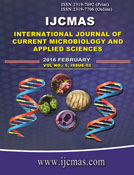


 National Academy of Agricultural Sciences (NAAS)
National Academy of Agricultural Sciences (NAAS)

|
PRINT ISSN : 2319-7692
Online ISSN : 2319-7706 Issues : 12 per year Publisher : Excellent Publishers Email : editorijcmas@gmail.com / submit@ijcmas.com Editor-in-chief: Dr.M.Prakash Index Copernicus ICV 2018: 95.39 NAAS RATING 2020: 5.38 |
Taif region is situated in the central foothills of the Sarawat mountains at an altitude of 2200 to 2500 m above the sea level. Special type of pomegranate is cultivated there and called taify pomegranate. Therefore, exploring the types of microorganisms tolerant to root exudates is important. The objective of this study was to identify bacteria, actinomycetes and potential bacterial pathogens of pomegranate roots and their antimicrobial susceptibility patterns as well as effect of fruit parts extract on isolated bacteria. A total of 102 isolate were isolated and identified by morphological, physiological, APi profiles and 16S-rRNA techniques. Out of 102 isolated bacteria, from free soil 38 (37.3%), rhizosphere 55(53.9%) and inside roots 9(8.8%). Isolated Actinomycetes represent 23 (22.5%), Streptomyces21 (20.6%) and Sacchromyces cerevieace 5(4.9%) of all isolated microorganisms. Isolates were identified as B. subtilis, S. cerevieace, S. pneumoniae, S. pyogenes, K. pneumoniae, A. baumannii, P. aerogenosa, A. chroococum, H. seropedicae, A. lipoferumand E.aerogenes. Susceptibility testing was done according to Clinical and Laboratory Standards Institute (CLSI) guideline. Tetracycline was effective against 75.5% of isolated pathogens. In general, Gram positive isolates were more susceptible to all antibiotic tested, whereas Gram negative isolates were less susceptible to all antibiotic tested. Antimicrobial activity of crude extracts of rind, fruit, and juice ofpomegranate fruitswere evaluated against 18Gram-positiveand 35 Gram-negative bacteria. Crude alcoholic extracts of rind, seeds extract (juice) and whole fruit were evaluated against isolated Gram-positive and Gram-negative by agar disc diffusion method. All fruit parts were active against all tested bacteria (B. subtilis, E. aerogenes, K. pneumonia and P. aerogenosa), and moreover, against N2-Fixing bacteria (A. chroococcum, A.lipoferum and H. seropedicae). Rind extract was less active against P. aeruginosa, juice against E. aerogenes, whole fruit extract against B. subtilis. In general, juice (seed extract) was relatively more active than extracts of other parts of the fruit. The descending order of activity of the extracted parts of the plant fruit was juice, rind and whole fruit, respectively. On the other hand, Gram- positive bacteria, B. subtilis S. pneumoniae and A. chroococcum were more sensitive than Gram-negative and their inhibition zones. Therefore, it may be concluded that fruits of pomegranate extracts have broad spectrum antimicrobial activity and their activity could be attributed, to a great extent, to their contents of alkaloids and flavonoids.
 |
 |
 |
 |
 |